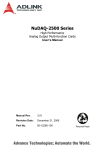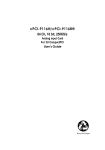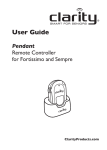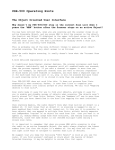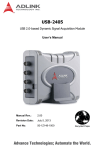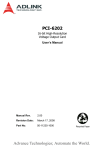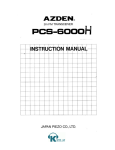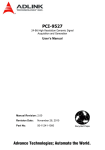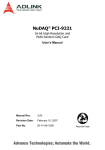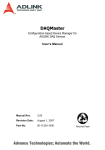Download ADLINK Technology NuDAQ-2500 Series User`s manual
Transcript
NuDAQ-2500 Series High Performance Analog Output and Multi-function Data Acquisition Cards User’s Manual Manual Rev. 2.01 Revision Date: March 19, 2006 Part No: 50-11221-2000 Advance Technologies; Automate the World. Copyright 2007 ADLINK TECHNOLOGY INC. All Rights Reserved. The information in this document is subject to change without prior notice in order to improve reliability, design, and function and does not represent a commitment on the part of the manufacturer. In no event will the manufacturer be liable for direct, indirect, special, incidental, or consequential damages arising out of the use or inability to use the product or documentation, even if advised of the possibility of such damages. This document contains proprietary information protected by copyright. All rights are reserved. No part of this manual may be reproduced by any mechanical, electronic, or other means in any form without prior written permission of the manufacturer. Trademarks Product names mentioned herein are used for identification purposes only and may be trademarks and/or registered trademarks of their respective companies. Getting service Customer satisfaction is our top priority. Contact us should you require any service or assistance. ADLINK TECHNOLOGY INC. Web Site Sales & Service Telephone No. Fax No. Mailing Address http://www.adlinktech.com [email protected] +886-2-8226-5877 +886-2-8226-5717 9F No. 166 Jian Yi Road, Chungho City, Taipei Hsien 235, Taiwan, ROC ADLINK TECHNOLOGY AMERICA, INC. Sales & Service Toll-Free Fax No. Mailing Address [email protected] +1-866-4-ADLINK (235465) +1-949-727-2099 8900 Research Drive, Irvine, CA 92618, USA ADLINK TECHNOLOGY EUROPEAN SALES OFFICE Sales & Service Toll-Free Fax No. Mailing Address [email protected] +49-211-4955552 +49-211-4955557 Nord Carree 3, 40477 Düsseldorf, Germany ADLINK TECHNOLOGY SINGAPORE PTE LTD Sales & Service Telephone No. Fax No. Mailing Address [email protected] +65-6844-2261 +65-6844-2263 84 Genting Lane #07-02A, Cityneon Design Center, Singapore 349584 ADLINK TECHNOLOGY INDIA LIAISON OFFICE Sales & Service Telephone No. Fax No. Mailing Address [email protected] +91-80-57605817 +91-80-26671806 No. 1357, Ground Floor, “Anupama”, Aurobindo Marg JP Nagar (Ph-1) Bangalore - 560078 ADLINK TECHNOLOGY BEIJING Sales & Service Telephone No. Fax No. Mailing Address [email protected] +82-2-20570565 +82-2-20570563 4F, Kostech Building, 262-2, Yangjae-Dong, Seocho-Gu, Seoul, 137-130, South Korea ADLINK TECHNOLOGY BEIJING Sales & Service Telephone No. Fax No. Mailing Address [email protected] +86-10-5885-8666 +86-10-5885-8625 Room 801, Building E, Yingchuangdongli Plaza, No.1 Shangdidonglu, Haidian District, Beijing, China ADLINK TECHNOLOGY SHANGHAI Sales & Service Telephone No. Fax No. Mailing Address [email protected] +86-21-6495-5210 +86-21-5450-0414 Floor 4, Bldg. 39, Caoheting Science and Technology Park, No.333 Qinjiang Road, Shanghai, China ADLINK TECHNOLOGY SHENZHEN Sales & Service Telephone No. Fax No. Mailing Address [email protected] +86-755-2643-4858 +86-755-2664-6353 C Block, 2nd Floor, Building A1, Cyber-tech Zone, Gaoxin Ave. 7.S, High-tech Industrial Park S., Nanshan District, Shenzhen, Guangdong Province, China Using this manual 1.1 Audience and scope This manual guides you when using ADLINK NuDAQ-2500 Series card. The card’s hardware, signal connections, and calibration information are provided for faster application building. This manual is intended for computer programmers and hardware engineers with advanced knowledge of data acquisition and high-level programming. 1.2 How this manual is organized This manual is organized as follows: Chapter 1 Introduction: This chapter introduces the NuDAQ2500 Series card including its features, specifications and software support information. Chapter 2 Installation: This chapter presents the card’s layout, package contents, and installation. Chapter 3 Signal Connections: This part describes the NuDAQ-2500 Series card signal connections. Chapter 4 Operation Theory: The operation theory of the NuDAQ-2500 Series card functions including A/D conversion, D/A conversion, and programmable function I/O are discussed in this chapter. Chapter 5 Calibration: The chapter offers information on how to calibrate the NuDAQ-2500 Series card for accurate data acquisition and output. Appendix: The Appendix demonstrates several waveform generation and other related information. Warranty Policy: This presents the ADLINK Warranty Policy terms and coverages. 1.3 Conventions Take note of the following conventions used throughout the manual to make sure that you perform certain tasks and instructions properly. NOTE Additional information, aids, and tips that help you perform particular tasks. IMPORTANT Critical information and instructions that you MUST perform to complete a task. WARNING Information that prevents physical injury, data loss, module damage, program corruption etc. when trying to complete a particular task. Table of Contents Table of Contents..................................................................... i List of Tables.......................................................................... iii List of Figures ........................................................................ iv 1 Introduction ........................................................................ 1 1.1 1.2 1.3 1.4 1.5 Features............................................................................... 1 Applications ......................................................................... 2 Specifications....................................................................... 3 Analog Output (AO) ........................................................ 3 Analog Input (AI) ............................................................. 4 General Purpose Digital I/O (G. P. DIO) ......................... 5 General Purpose Timer/ Counter (GPTC) ...................... 5 Analog Trigger (A.Trig) ................................................... 5 System Synchronous Interface (SSI) .............................. 6 Calibration ....................................................................... 6 Physical .......................................................................... 6 Operating Environment ................................................... 6 Storage Environment ...................................................... 6 Block Diagram ..................................................................... 7 Software Support ................................................................. 8 Programming Library ...................................................... 8 DAQ-LVIEW PnP: LabVIEW Driver ................................ 9 D2K-OCX: ActiveX Controls ........................................... 9 2 Installation ........................................................................ 11 2.1 2.2 2.3 2.4 Package Contents ............................................................. 11 Unpacking.......................................................................... 12 Card Layout ....................................................................... 13 DAQe-2502/2501 .......................................................... 13 DAQ-2502/2501 ............................................................ 14 DPXI-2501/2502 ........................................................... 15 PCI Configuration .............................................................. 16 Plug and Play ............................................................... 16 Configuration ................................................................ 16 Troubleshooting ............................................................ 16 Table of Contents i 3 Signal Connections .......................................................... 17 3.1 Connectors Pin Assignment............................................... 17 4 Operation Theory .............................................................. 21 4.1 4.2 4.3 4.4 4.5 4.6 A/D Conversion.................................................................. 21 AD Data Format ............................................................ 22 Acquisition Modes ......................................................... 23 Scan Timing and Procedure ......................................... 24 Trigger Modes ............................................................... 26 Bus-mastering DMA Data Transfer ............................... 29 D/A Conversion.................................................................. 31 Architecture ................................................................... 31 Hardware-Controlled Waveform Generation ................ 32 Data Format in FIFO and Mapping ............................... 33 Setting up the DACs ..................................................... 33 Using DACs’ Multiplying Characteristic ........................ 34 Software Update ........................................................... 34 Waveform Generation ................................................... 35 Waveform Generation Timing ....................................... 36 Trigger Modes ............................................................... 38 Iterative Waveform Generation ..................................... 41 General Purpose Digital I/O .............................................. 45 General Purpose Timer/Counter Operation ....................... 46 Basics Timer/Counter Function Basics ......................... 46 General Purpose Timer/Counter Modes ....................... 47 Trigger Sources ................................................................. 52 Software-Trigger ........................................................... 52 External Analog Trigger ................................................ 52 Timing Signals ................................................................... 56 System Synchronization Interface ................................ 57 5 Calibration ......................................................................... 59 5.1 5.2 5.3 Loading Calibration Constants........................................... 59 Auto-calibration .................................................................. 60 Saving Calibration Constants............................................. 60 Appendix ................................................................................ 61 Warranty Policy ..................................................................... 65 ii Table of Contents List of Tables Table 3-1: VHDCI-type (68-pin) Connector Pin Assignment ... Table 3-2: VHDCI-type (68-pin) Connector Legend ................ Table 4-1: Bipolar Input Range and Converted Digital Codes ......................................... Table 4-2: Unipolar Input Range and Converted Digital Codes ......................................... Table 4-3: Trigger Modes and Corresponding Trigger Sources ............................. Table 4-4: Summary of Counters for Programmable Scan ...... Table 4-5: D/A Output Versus Digital Codes ........................... Table 4-6: Trigger Signals and Corresponding Signal Sources ............................... Table 4-7: Summary of Counters for Waveform Generation ... Table 4-8: Ideal Transfer Characteristic of Analog Trigger SRC1 (EXTATRIG) ........................ List of Tables 18 19 22 22 23 24 34 35 36 53 iii List of Figures Figure 1-1: DAQ-/DAQe-/PXI-2502/2501 Block Diagram ............ 7 Figure 2-1: DAQe-2502/2501 Card Layout ................................ 13 Figure 2-2: DAQ-2502/2501 Card Layout .................................. 14 Figure 2-3: DAQ-2502/2501 Card Layout .................................. 15 Figure 4-1: Scan Timing............................................................. 25 Figure 4-2: Post Trigger ............................................................. 26 Figure 4-3: Delay Trigger ........................................................... 27 Figure 4-4: Post Trigger with Retrigger ...................................... 28 Figure 4-5: Scatter/gather DMA ................................................. 30 Figure 4-6: Block Diagram of D/A Group ................................... 31 Figure 4-7: FIFO Data Format.................................................... 32 Figure 4-8: Typical D/A Timing of Waveform Generation .......... 37 Figure 4-9: Post Trigger Generation .......................................... 38 Figure 4-10: Delay-Trigger Generation ........................................ 39 Figure 4-11: Post Trigger or Delay-Trigger Generation with Retrigger .................................................................. 40 Figure 4-12: Finite Iterative Waveform Generation with Post-trigger .............................................................. 41 Figure 4-13: Post Trigger or Delay-Trigger Generation with Retrigger .................................................................. 41 Figure 4-14: Stop Mode I ............................................................. 43 Figure 4-15: Stop Mode II ............................................................ 44 Figure 4-16: Stop Mode III ........................................................... 44 Figure 4-17: Mode1 Operation ..................................................... 47 Figure 4-18: Mode2 Operation ..................................................... 48 Figure 4-19: Mode 3 Operation .................................................... 48 Figure 4-20: Mode4 Operation ..................................................... 49 Figure 4-21: Mode5 Operation ..................................................... 49 Figure 4-22: Mode6 Operation ..................................................... 50 Figure 4-23: Mode7 Operation ..................................................... 50 Figure 4-24: Mode8 Operation ..................................................... 51 Figure 4-25: Analog Trigger Block Diagram................................. 52 Figure 4-26: Below-Low Analog Trigger Condition ...................... 53 Figure 4-27: Above-High Analog Trigger Condition ..................... 54 Figure 4-28: Inside-Region Analog Trigger Condition.................. 54 Figure 4-29: High-Hysteresis Analog Trigger Condition............... 55 Figure 4-30: Low-Hysteresis Analog Trigger Condition ............... 55 Figure 4-31: DAQ Signals Routing............................................... 56 iv List of Figures 1 Introduction The NuDAQ-2500 Series features the DAQ-/DAQe-/PXI-2502/ 2501 advanced analog output card based on the 32-bit PCI/PCI Express®/PXI architecture. With high-performance designs and state-of-the-art technology, these cards are ideal for waveform generation, industrial process control, and signal analysis applications in medical, process control, etc. 1.1 Features The NuDAQ-2500 Series cards come with the following features: X 32-bit PCI/PCI Express/PXI bus, plug and play X Up to 1 MS/s analog output rate and up to 400 KS/s analog input rate X Analog output / input channels Z DAQ-/DAQe-/PXI-2502: 8 / 4 Z DAQ-/DAQe-/PXI-2501: 4 / 8 X Programmable bipolar/unipolar range for analog input channels and individual analog output channels X Programmable internal/external reference for individual analog output channels X D/A FIFO size: Z DAQ-/DAQe-/PXI-2502: 16K samples Z DAQ-/DAQe-/PXI-2501: 8K samples X A/D FIFO size: 2K samples X Versatile trigger sources including software trigger, external digital trigger, analog trigger, and System Synchronization Interface (SSI) trigger X A/D data transfer employing software polling and bus-mastering DMA with scatter/gather X D/A data transfer employing software update and bus-mastering DMA with scatter/gather X A/D trigger modes including post-trigger and delay-trigger with re-trigger functionality X D/A outputs with waveform generation capability Introduction 1 X System Synchronization Interface (SSI) X A/D and D/A fully auto-calibration X Built-in programmable D/A external reference voltage compensator X Jumper-less operation and software-configurable 1.2 Applications 2 X Automotive testing X Arbitrary waveform generator X Transient signal measurement X ATE X Laboratory automation X Biotech measurement Introduction 1.3 Specifications Analog Output (AO) X Channels: Z DAQ-/DAQe-/PXI-2501: 4-CH Z DAQ-/DAQe-/PXI-2502: 8-CH X DA converter: AD7945 X Maximum update rate: 1 MS/s X Resolution: 12-bit X FIFO buffer size: Z DAQ-/DAQe-/PXI-2501: 8K Z DAQ-/DAQe-/PXI-2502: 16K X Data transfer: Programmed I/O, and bus-mastering DMA with scatter/gather X Voltage reference: Internal 10 V or external up to ±10 V X Output range: Z Bipolar: ±10 V or ±external reference Z Unipolar: 0 V to 10V or 0 V to external reference X Settling time for –10 V to +10 V step: 2 µs X Slew rate: 20 V/µs X Output coupling: DC X Protection: Short-circuit to ground X Output impedance: 0.1 Ω max. X Output current: ±5 mA max. X Power-on state: 0V steady-state X Power-on glitch: ±600 mV/500 µs X Offset error: X Z Before calibration: ±80 mV max Z After calibration: ±2 mV max Gain error: Z Before calibration: ±0.8% of output max Z After calibration: ±0.02% of output max Introduction 3 Analog Input (AI) X Z DAQ-/PXI-2502: 4 single-ended Z DAQ-/PXI-2501: 8 single-ended X AD converter: LTC1416 X Max sampling rate: 400 KS/s X Resolution: 14-bit X FIFO buffer size: 2K samples X Input range Z Bipolar: ±10 V Z Unipolar: 0 V to 10 V X Over-voltage protection: Continuous, ±35 V maximum X Input impedance: 1 GΩ / 6 pF X Trigger modes: Pre-trigger, post-trigger, middle-trigger, and delay trigger X Data transfers: Programmed I/O and bus-mastering DMA with scatter/gather X Input coupling: DC X Offset error: X 4 Channels: Z Before calibration: ±40 mV max Z After calibration: ±1 mV max Gain error: Z Before calibration: ±0.4% of max output Z After calibration: ±1 mV of max output Introduction General Purpose Digital I/O (G. P. DIO) X Channels: 24 programmable input/output X Compatibility: TTL/CMOS X Input voltage: X Z Logic Low: VIL=0.8 V max; IIL=0.2 mA max Z High: VIH=2.0 V max; IIH=0.02 mA max Output voltage: Z Low: VOL=0.5 V max; IOL=8 mA max Z High: VOH=2.7 V min; IOH=400 µA General Purpose Timer/ Counter (GPTC) X Channels: Two up/down timer/counters X Resolution: 16-bit X Compatibility: TTL/CMOS X Clock source: Internal or external X Maximum source frequency: 10 MHz Analog Trigger (A.Trig) X Source: External analog trigger (EXTATRIG) X Level: ±10V external X Resolution: 8-bit X Slope: Positive or negative (software selectable) X Hysteresis: Programmable X Bandwidth: 400 KHz X External Analog Trigger Input (EXTATRIG) X Impedance: 40 KΩ X Coupling: DC X Protection: Continuous ±35V maximum Introduction 5 System Synchronous Interface (SSI) X Trigger lines: 7 Calibration X Recommended warm-up time: 15 minutes X Onboard reference: 5.0 V X Temperature coefficient: ±2 ppm/°C X Long-term stability: 6 ppm/1000 hr Physical X Dimension: 175 mm by 107 mm X I/O connector: 68-pin female mini-SCSI type X Power Requirement: +5 VDC; 1.6 A typical Operating Environment X Ambient temperature: 0°C to 55°C X Relative humidity: 10% to 90% non-condensing Storage Environment 6 X Ambient temperature: -20 to 70°C X Relative humidity: 5% to 95% non-condensing Introduction 1.4 Block Diagram Figure 1-1: DAQ-/DAQe-/PXI-2502/2501 Block Diagram Introduction 7 1.5 Software Support ADLINK provides versatile software drivers and packages for users’ different approach to building up a system. ADLINK not only provides pro-gramming libraries such as DLL for most Windowsbased systems, but also provide drivers for other software packages such as LabVIEW®. All software options are included in the ADLINK CD. Non-free software drivers are protected with licensing codes. Without the software code, you can install and run the demo version for two hours for trial/demonstration purposes. Please contact ADLINK dealers to purchase the formal license. Programming Library For customers who are writing their own programs, we provide function libraries for many different operating systems, including: 8 X D2K-DASK: Include device drivers and DLL for Windows® 98/NT/2000/XP. DLL is binary compatible across Windows 98/NT/2000/XP. This means all applications developed with D2K-DASK are compatible across Windows 98/NT/2000/ XP. The developing environment can be VB, VC++, Delphi, BC5, or any Windows programming language that allows calls to a DLL. The user’s guide and function reference manual of D2K-DASK are in the CD. (\\Manual\Software Package\D2K-DASK) X D2K-DASK/X: Include device drivers and shared library for Linux. The developing environment can be Gnu C/C++ or any programming language that allows linking to a shared library. The user's guide and function reference manual of D2K-DASK/X are in the CD. (\\Manual\Software Package\D2K-DASK-X.) Introduction DAQ-LVIEW PnP: LabVIEW Driver DAQ-LVIEW PnP contains the VIs, which are used to interface with NI’s LabVIEW software package. The DAQ-LVIEW PnP supports Windows 98/NT/2000/XP. The LabVIEW drivers is shipped free with the card. You can install and use them without a license. For detailed information about DAQ-LVIEW PnP, refer to the user’s guide in the CD. (\\Manual\Software Package\DAQ-LVIEW PnP) D2K-OCX: ActiveX Controls Customers who are familiar with ActiveX controls and VB/VC++ programming are suggested to use D2K-OCX ActiveX control component libraries for developing applications. D2K-OCX is designed for Windows 98/NT/2000/XP. For more details on D2KOCX, refer to the user's guide in the CD. (\\Manual\Software Package\D2K-OCX) The above software drivers are shipped with the card. Refer to the Software Installation Guide in the package to install these drivers. In addition, ADLINK supplies ActiveX control software DAQBench. DAQBench is a collection of ActiveX controls for measurement or automation applications. With DAQBench, you can easily develop custom user interfaces to display your data, analyze data you acquired or received from other sources, or integrate with popular applications or other data sources. For more detailed information about DAQBench, refer to the user's guide in the CD. (\\Manual\Software Package\DAQBench Evaluation) You can also get a free 4-hour evaluation version of DAQBench from the CD. DAQBench is not free. Contact ADLINK or your dealer to purchase the software license. Introduction 9 10 Introduction 2 Installation This chapter describes how to install the DAQ-/DAQe-/PXI-2502/ 2501 card. The contents of the package and unpacking information that you should be aware of are outlined first. The DAQ-/DAQe-/PXI-2502/2501 card performs an automatic configuration of the IRQ and port address. You can use the PCI_SCAN software utility to read the system configuration. 2.1 Package Contents In addition to this User's Manual, the package includes the following items: X DAQ-/DAQe-/PXI-2502/2501 multi-function data acquisition card X ADLINK All-in-one CD X Software Installation Guide If any of these items are missing or damaged, contact the dealer from whom you purchased the product. Save the shipping materials and carton in case you want to ship or store the product in the future. Installation 11 2.2 Unpacking Your DAQ-/DAQe-/PXI-2502/2501 card contains electro-static sensitive components that can be easily be damaged by static electricity. Therefore, the card should be handled on a grounded anti-static mat. The operator should be wearing an anti-static wristband, grounded at the same point as the anti-static mat. Inspect the card package for obvious damages. Shipping and handling may cause damage to the card. Be sure there are no shipping and handling damages on the modules carton before continuing. After opening the card module carton, extract the system module and place it only on a grounded anti-static surface with component side up. Again, inspect the module for damages. Press down on all the socketed IC's to make sure that they are properly seated. Do this only with the module place on a firm flat surface. You are now ready to install your DAQ-/DAQe-/PXI-2502/2501 card. NOTE 12 DO NOT APPLY POWER TO THE CARD IF IT HAS BEEN DAMAGED. Installation 2.3 Card Layout DAQe-2502/2501 Figure 2-1: DAQe-2502/2501 Card Layout Installation 13 DAQ-2502/2501 Figure 2-2: DAQ-2502/2501 Card Layout 14 Installation DPXI-2501/2502 Figure 2-3: DAQ-2502/2501 Card Layout Installation 15 2.4 PCI Configuration Plug and Play With support for plug and play, the card requests an interrupt number via its PCI controller. The system BIOS responds with an interrupt assignment based on the card information and on known system parameters. These system parameters are determined by the installed drivers and the hardware load seen by the system. Configuration The board configuration is done on a board-by-board basis for all PCI boards in the system. Because configuration is controlled by the system and software, there is no jumper setting required for base address, DMA, and interrupt IRQ. The configuration is subject to change with every boot of the system as new boards are added or removed. Troubleshooting If your system doesn’t boot or if you experience erratic operation with your PCI board in place, it is likely caused by an interrupt conflict. The BIOS Setup may be incorrectly configured. Consult the BIOS documentation that comes with your system to solve this problem. 16 Installation 3 Signal Connections This chapter describes DAQ-/DAQe-/PXI-2502/2501 card connectors and the signal connection between the DAQ-/DAQe-/PXI2502/2501 card and external devices. 3.1 Connectors Pin Assignment The DAQ-/DAQe-/PXI-2502/2501 card is equipped with two 68-pin VHDCI-type connectors (AMP-787254-1). These are used for digital input/output, analog input/output, timer/counter signals, etc. The pin assignments of the connectors are defined in Table 3-1. Signal Connections 17 AO_0 AO_1 AO_2 AO_3 AOEXTREF_A/AI_0 AI_1 EXTATRIG/AI_2 AOEXTREF_B/AI_3 AO_4/AI_4 AO_5/AI_5 AO_6/AI_6 AO_7/AI_7 AO_TRIG_OUTA AO_TRIG_OUTB GPTC1_SRC GPTC0_SRC GPTC0_GATE GPTC0_OUT GPTC0_UPDOWN RESERVED AFI1 PB7 PB5 PB3 PB1 PC7 PC5 DGND PC3 PC1 PA7 PA5 PA3 PA1 1 2 3 4 5 6 7 8 9 10 11 12 13 14 15 16 17 18 19 20 21 22 23 24 25 26 27 28 29 30 31 32 33 34 35 36 37 38 39 40 41 42 43 44 45 46 47 48 49 50 51 52 53 54 55 56 57 58 59 60 61 62 63 64 65 66 67 68 AGND AGND AGND AGND AGND AGND AGND AGND AGND AGND AGND AGND EXTWFTRG_A EXTWFTRG_B VCC DGND GPTC1_GATE GPTC1_OUT GPTC1_UPDOWN DGND AFI0 PB6 PB4 PB2 PB0 PC6 PC4 DGND PC2 PC0 PA6 PA4 PA2 PA0 Table 3-1: VHDCI-type (68-pin) Connector Pin Assignment 18 Signal Connections Legend: Pin # Signal Name Reference Direction Description Voltage output of DA channel <0..3> 1~4 AO_<0..3> AGND Output 5 AOEXTREF_A/AI_0 AGND Input External reference for AO channel <0..3> / AI input 2 6 AI_1 AGND Input AI input 0 7 EXTATRIG/AI_2 AGND Input External analog trigger / AI input 1 8 AOEXTREF_B/AI_3 AGND Input External reference for AO channel <4..7> / AI input 3 9~12 AO_<4..7>/AI_<4..7> AGND Output/Input Voltage output of DA channel <4..7> / AI channel <4..7> (only for DAQ-2501) 13,14 AO_TRIG_OUT_<A,B> DGND Output AO trigger signal for channel <0..3> <4..7> 15,16 GPTC<0,1>_SRC DGND Input Source of GPTC<0,1> 17,51 GPTC<0,1>_GATE DGND Input Gate of GPTC<0,1> 18,52 GPTC<0,1>_OUT DGND Input Output of GPTC<0,1> 19,53 GPTC<0,1>_UPDOWN DGND Input 20 RESERVED — — 21,55 AFI<1,0> DGND Input Auxiliary Function Input Up/Down of GPTC<0,1> Reserved Pin ,22,56,23,57 ,24,58,25,59 PB<7,0> DGND PIO* Programmable DIO of 8255 Port B 26,60,27,61, 29,63,30,64 PC<7,0> DGND PIO* Programmable DIO of 8255 Port C 31,65,32,66, 33,67,34,68 PA<7,0> DGND PIO* Programmable DIO of 8255 Port A 35~46 AGND — — 47,48 EXTWFTRIG_<A,B> DGND Input 49 VCC DGND Power (Output) 28,50,54,62 DGND — — Analog ground External waveform trigger for AO channel <0..3> <4..7> +5V Power Source Digital ground Table 3-2: VHDCI-type (68-pin) Connector Legend *PIO means Programmable Input/Output Signal Connections 19 20 Signal Connections 4 Operation Theory The operation theories of the DAQ-/DAQe-/PXI-2502/2501 card are described in this chapter. The functions include A/D conversion, D/A conversion, digital I/O, and general purpose counter/ timer. This operation theory will help you understand how to configure and program the DAQ-/DAQe-/PXI-2502/2501 card. 4.1 A/D Conversion When using an A/D converter, you must know about the properties of the signal to be measured. You may decide which channel to use and how to connect the signals to the card. Refer to section 3.4. In addition, users should define and control the A/D signal configurations, including channels, gains, and polarities (unipolar/ bipolar). The A/D acquisition is initiated by a trigger source and you must decide how to trigger the A/D conversion. The data acquisition will start once a trigger condition is matched. After the end of an A/D conversion, the A/D data is buffered in a Data FIFO. The A/D data can now be transferred into the system memory for further processing. Software polling and programmable scan acquisition modes are described in this chapter, as well as timing, trigger modes, trigger sources, and transfer methods. Operation Theory 21 AD Data Format The data format of the acquired 14-bit A/D data is coded in 2’s complement. Table 4-1 and Table 4-2 lists the valid input ranges and the ideal transfer characteristics. Magnitude FSR LSB FSR-1LSB Bipolar Input Range ±10V ±5V ±2.5V ±1.25V 1120.78uV 610.39uV 305.19uV 152.60uV 9.998779V 4.999389V 2.499694V 1.249847V Midscale + LSB 1120.78uV Midscale 0V -10V 1FFF 610.39uV 305.19uV 152.60uV 0001 0V 0V 0V 0000 -305.19uV -152.60uV 3FFF -2.5V -1.25V 2000 Midscale - LSB -1120.78uV -610.39uV -FSR Digital code -5V Table 4-1: Bipolar Input Range and Converted Digital Codes Magnitude FSR LSB FSR Unipolar Input Range Digital code 0V ~ 10V 0 ~ +5V 0 ~ +2.5V 0 ~ +1.25V 610.39uV 305.19uV 152.60uV 76.3uV - LSB 4.999389V 2.499694V 1.249847V 1.249923V 1FFF Midscale + LSB 5.000611V 2.500306V 1.250153V 0.625076V 0001 Midscale 5V 2.5V 1.25V 0.625V Midscale - LSB 4.999389V 2.499694V 1.249847V 1.249923V -FSR 0V 0V 0V 0V 0000 3FFF 2000 Table 4-2: Unipolar Input Range and Converted Digital Codes 22 Operation Theory Acquisition Modes Software Polling This is the easiest way to acquire a single A/D data. The A/D converter starts one conversion whenever the dedicated software command is executed. Then the software would poll the conversion status and read the A/D data back when it is available. This method is very suitable for applications that needs to process A/D data in real time. Under this mode, the timing of the A/D conversion is fully controlled by the software. However, it is difficult to control the A/D conversion rate. Programmable Scan This method is suitable for applications that need to acquire A/ D data at a precise and fixed rate. A scan is a group of multiple channel samples and the scan interval is defined by the SI_counter. Likewise, the sample interval of the multiple channels is defined by the SI2_counter. Refer to Table 4-4 for more information. The DAQ-/DAQe-/PXI-2502/2501 card can sample multiple channels in continuous/discontinuous ascending sequence. For example, you may program the DAQ-/DAQe-/PXI-2502/ 2501 card to perform a scan in the channel sequence of 1-2-41-2-4. Three trigger modes are available in programmable scan: post-trigger, delay-trigger, and post/delay-trigger with retrigger. Refer to Table 4-3 for a brief summary on trigger modes and their trigger sources. Trigger Mode Description Post-Trigger Perform a scan right after the trigger occurs. Delay-Trigger Scan delayed by the amount of time programmed after the trigger. Post/Delay-Trigger with Retrigger Perform repeated scan while trigger occurs and it could be under PostTrigger or De-lay-Trigger mode. Trigger Sources Software Trigger Digital Trigger Analog Trigger SSI AD Trigger Table 4-3: Trigger Modes and Corresponding Trigger Sources Operation Theory 23 Scan Timing and Procedure There are four counters that need to be specified prior to programmable scans. Refer to Table 4-4 for details. Counter Name Width Description Notes SI_counter Scan Interval defines the 24-bit interval between each scan. Scan Interval = SI_counter / Time-base* SI2_counter Sampling Interval defines 24-bit the interval between each sampled channel. Sampling Interval = SI2_counter / Timebase* PSC_counter Post Scan Counts defines how many scans to be 24-bit performed with respect to each trigger. Delay_counter 16-bit Define the delay time for scan after trigger. Delay Time = (Delay_counter / Timebase*), Timebase*=40M for DAQ/DAQe/PXI-2502/ 2501 Table 4-4: Summary of Counters for Programmable Scan 24 Operation Theory The relationship between counters and acquisition timing is illustrated in Figure 4-1. Figure 4-1: Scan Timing NOTE The maximum A/D sampling rate is 400 KHz for DAQ-/ DAQe-/PXI-2502/2501 card. The minimum setting of SI2_counter is 100. The Scan Interval may not be smaller than the interval of data Sampling Interval multiplied by the Number of channels per Scan. For example: SI_counter >= SI2_counter * NumChan_Counter. Operation Theory 25 Trigger Modes Post-Trigger Acquisition Use post-trigger acquisition when you want to perform scans right after a trigger signal. The number of scans to be performed after the trigger signal is specified by the PSC_counter, as illustrated in Figure 4-2. The total acquired data length is equal to: (number_of_channels_enabled_for_scan_acquisition ) * PSC_counter Figure 4-2: Post Trigger 26 Operation Theory Delay Trigger Acquisition Use delay trigger when you want to delay the scan after a trigger signal. The delay time is determined by the Delay_counter, as shown in Figure 4-3. The counter counts down on the rising edges of Delay_counter clock source after the trigger signal. When the count reaches 0, the DAQ-/DAQe-/PXI-2502/2501 card starts to perform the scan. The acquired data length is equal to the: (number_of_channels_enabled_for_scan_acquisition ) * PSC_counter The Delay_counter clock source can be software selected from internal 40 MHz Timebase, external input (AFI-1), or General Purpose Timer/Counter Output 0/1. Figure 4-3: Delay Trigger Operation Theory 27 Post-Trigger or Delay-trigger Acquisition with Retrigger Use post-trigger or delay-trigger acquisition with retrigger when you want to perform repeated scans with respect to the repeated triggers. Figure 4-4 illustrates this mode. Two scans are performed after the first trigger signal, and then waits for the next trigger signal. When the trigger signal occurs, it performs two more scans. When retrigger function is disabled, only one trigger signal is be accepted after retrigger. NOTE Retrigger signals asserted during scan process will be ignored. Figure 4-4: Post Trigger with Retrigger 28 Operation Theory Bus-mastering DMA Data Transfer Bus Mastering DMA Mode PCI bus-mastering DMA is necessary for high speed DAQ in order to utilize the maximum PCI bandwidth. The bus-mastering controller, which is built in the PLX PCI controller, controls the PCI bus when it becomes the master of the bus. Bus mastering reduces the required size of the onboard memory and reduces the CPU loading because data is directly transferred to the computer’s memory without host CPU intervention. The hardware temporarily stores the acquired data in the onboard Data FIFO buffer, then transfers the data to the userdefined DMA buffer in the host PC’s memory. Bus-mastering DMA utilizes the fastest available transfer rate of PCI-bus. Once the analog acquisition operation starts, control returns to your program. The DMA transfer mode is complicated to program. We recommend using a high-level program library to configure this card. If users would like to know more about software programs that can handle the DMA bus master data transfer, visit to http:// www.plxtech.com for more information on PCI controllers. DMA with Scatter Gathering Capability In multi-user or multi-tasking OS such as Microsoft Windows, Linux, etc., it is difficult to allocate a large continuous memory block to do the DMA transfer due to memory fragmentation. PLX PCI controller provides scatter/gather or chaining mode to link non-continuous memory blocks into a linked list, so you can transfer large amounts of data without being limited by the fragment of memory blocks. You can configure the linked list for the input DMA channel and the output DMA channel, individually. Figure 4-5 shows a linked list that is constructed by three DMA descriptors. Each descriptor contains a PCI address, a local address, a transfer size, and the pointer to the next descriptor. You can collect fragmented memory blocks and chain their associative DMA descriptors altogether. The DAQ-/DAQe-/ PXI-2502/2501 software driver simple settings for the scatter/ Operation Theory 29 gather function, including some sample programs in the ADLINK All-in-One CD. Figure 4-5: Scatter/gather DMA 30 Operation Theory 4.2 D/A Conversion The DAQ-/DAQe-/PXI-2502/2501 card offers flexible and versatile analog output scheme to fit your complex field applications. In order to take full advantages of the DAQ-/DAQe-/PXI-2502/2501 card, it is suggested that you carefully read this section. Architecture There are up to eight channels of 12-bit Digital-to-Analog Converter (DAC) available in the DAQ-/DAQe-/PXI-2502/2501 card. Four D/A channels are packed into one D/A group. The DAQ-/ DAQe-/PXI-2502 comes with two D/A groups, while the DAQ-/ DAQe-/PXI-2501 card has only one D/A group. Figure 4-6: Block Diagram of D/A Group (Group B of DAQ/DAQe-/PXI-2502 is identical to Group A shown above.) Figure 4-6 shows the D/A block diagram. DAC are controlled implicitly by CPLD and have their outputs updated only when digital codes for all enabled DA channels are ready and latched. This ensures D/A conversions to be synchronized for each channel in the same D/A group. You can use this property to perform multichannel waveform generation without any phase-lag. Operation Theory 31 Hardware-Controlled Waveform Generation FIFO is a hardware first-in first-out data queue that holds temporary digital codes for D/A conversion. When the DAQ-/DAQe-/PXI2502/2501 card operates in waveform generation mode, the waveform patterns are stored in FIFO with 8K maximum samples. Waveform patterns larger than 8K are also supported by utilizing bus-mastering DMA transfer supported by the PCI controller. The data format in FIFO is shown in Figure 4-7. Figure 4-7: FIFO Data Format 32 Operation Theory Data Format in FIFO and Mapping With hardware-based waveform generation, D/A conversions are updated automatically by CPLD rather than application software. Unlike the conventional software-based waveform generation, the precise hardware timing control guarantees non-distorted waveform generation even when host CPU is under heavy loading. Detailed function setup are discussed later on this chapter. NOTE When using waveform generation mode, all the four DACs in the same D/A group must be configured for the same mode. However, any one of the DAC can be disabled. If you need to use the software update mode, you can use another D/A group on the DAQ-/DAQe-/PXI2502 card. Setting up the DACs Before using the DACs, you must setup the reference source and its polarity. Each DAC has its own reference and polarity settings. For example, the internal voltage reference of D/A Group A is tied to internal +10V. However, you can still connect external reference through AOEXTREF (pin 5 on CN2) to a +3.3V voltage source, giving each DAC in D/A Group A two reference options: 10V or 3.3V. However, DA update timing, trigger source, and trigger/stop mode are all the same throughout a D/A Group. The DAQ-/DAQe-/PXI-2502/2501 card provides the capability to fine tune the voltage reference from the external source. The external reference is fed thru an onboard calibrated circuit, with programmable offset. You can use this capability to generate precise D/A outputs. CAUTION The range of external voltage reference should be within ±10V. Operation Theory 33 Using DACs’ Multiplying Characteristic The D/A reference selection let you fully utilize the multiplying characteristics of the DACs. Digital codes sent to the D/A converters are multiplied by the reference to generate output. Bipolar Magnitude Unipolar Output Output Digital Code FSR – LSB +Vref * (2046 / 2048) Vref * (4095 / 4096) 0FFF Midscale + LSB +Vref * (1 / 2048) Vref * (2049 4096) 0801 Midscale 0 Vref * (2048 / 4096) 0800 Midscale – LSB -Vref * ( 1 / 2048) Vref * (2047 / 4096) 07FF -FSR + LSB -Vref * (2046 / 2048) Vref * ( 0001 -FSR -Vref 1 / 4096) 0 0000 Table 4-5: D/A Output Versus Digital Codes The DAQ-/DAQe-/PXI-2502/2501 card can generate standard and arbitrary functions, continuously or piece-wisely. The Appendix illustrates all possible waveform patterns generated by the DAQ-/ DAQe-/PXI-2502/2501 card in combination with various counters, clock sources, and voltage references. Software Update This method is suitable for applications that need to generate D/A output controlled by user programs. In this mode, the D/A converter generates one output once the software command is issued. However, it is difficult to determine the software update rate under a multi-task OS like Windows. 34 Operation Theory Waveform Generation This method is suitable for applications that need to generate waveforms at a precise and fixed rate. Various programmable counters will facilitate users to generate complex waveforms with great flexibility. Three event signals are involved in waveform generation: Start, DAWR (DA WRite), and Stop. Refer to Table 4-6 for a brief summary of waveform generation events and their corresponding trigger sources. Event Signal Descriptions Trigger Sources Start Start Waveform Generation process. Software Trigger Ext. Digital Trigger Analog Trigger SSI Trigger DAWR Write data to the DAC on the falling edges of DAWR. Internal Update External Update SSI Update Stop Stop Waveform Generation Software Trigger Ext. Digital Trigger Analog Trigger Table 4-6: Trigger Signals and Corresponding Signal Sources Operation Theory 35 Waveform Generation Timing Six counters interact with the waveform to generate different DAWR timing, thus forming different waveforms. These are described in Table 4-7. Counter Name Width Description Note UI_counter Update Interval, which defines the update inter24-bit val between each data output. UC_counter Update Counts, which 24-bit defines the number of data in a waveform. IC_counter Iteration Counts, which defines how many times 16-bit the waveform is generated. DLY1_counter Define the delay time for 16-bit waveform generation after the trigger signal. DLY2_counter Define the delay time to separate consecutive waveform generation. Delay Time =(DLY2_counter 16-bit Effective only in Iterative / Clock Timebase) Waveform Generation mode. Trig_counter Define the acceptable start trigger count when 16-bit re-trigger function is enabled Update Interval = UI_counter / Time-base*. When value in UC_counter is smaller than the size of waveform patterns, the waveform is generated piece-wisely. Delay Time = (DLY1_counter / Clock Timebase) Timebase*=40M for DAQ/ PXI-2500 Series Table 4-7: Summary of Counters for Waveform Generation NOTE 36 The maximum D/A update rate is 1 MHz. The minimum UI_counter setting is 40. Operation Theory Figure 4-8: Typical D/A Timing of Waveform Generation (Assuming the data in the data buffer are 2V, 4V, -4V, 0V) Operation Theory 37 Trigger Modes Post-Trigger Generation Use post-trigger generation when you want to generate waveform right after a trigger signal. The number of patterns to be updated after the trigger signal is specified by UC_counter* IC_counter, as illustrated in Figure 4-9. Figure 4-9: Post Trigger Generation 38 Operation Theory Delay-Trigger Generation Use delay-trigger when you want to delay the waveform generation after the trigger signal. The delay time is determined by DLY1_counter as shown in Figure 4-10. The counter counts down on the rising edges of DLY1_counter clock source after the start trigger signal. When the count reaches zero, the DAQ-/DAQe-/PXI-2502/2501 card starts to generate the waveform. The DLY1_counter clock source can be software selected from the internal 40 MHz timebase, external clock input (AFI-0), or GPTC output 0/1. Figure 4-10: Delay-Trigger Generation Operation Theory 39 Post-Trigger or Delay-Trigger with Retrigger Use post-trigger or delay-trigger with retrigger when you want to generate multiple waveforms with respect to multiple incoming trigger signals. You can set Trig_counter to specify the number of acceptable trigger signals. Figure 4-11 illustrates this example with an Iterative Waveform Generation. Refer to next section for details. Two waveforms are generated after the first trigger signal. The board then waits for another trigger signal. When the next trigger signal is asserted, the board generates two more waveforms. After three trigger signals, as specified in Trig_Counter, no more triggers signals are accepted unless software trigger reset command is executed. NOTE Start Trigger signals asserted during the waveform generation process are ignored. Figure 4-11: Post Trigger or Delay-Trigger Generation with Retrigger 40 Operation Theory Iterative Waveform Generation You can set the IC_counter to generate iterative waveforms, no matter which trigger mode is used. The IC_counter stores the iteration number. Examples shown in Figure 4-12 and Figure 4-13 assumes that the digital codes in the FIFO are 2V, 4V, 2V, and 0V. Figure 4-12: Finite Iterative Waveform Generation with Post-trigger Figure 4-13: Post Trigger or Delay-Trigger Generation with Retrigger Operation Theory 41 When IC_counter is disabled, the waveform generation does not stop until a stop trigger is asserted. For Stop Mode, refer to the next section. An onboard data FIFO is used to buffer the waveform patterns for waveform generation. If the size of a single waveform is smaller than that of the FIFO, after initially loading the data from the host memory, the data in FIFO is re-used when a single waveform generation is completed. It does not occupy the PCI bandwidth afterwards. However, if the size of a single waveform is larger than that of the FIFO, it needs to be intermittently loaded from the host memory via DMA, thus occupying the PCI bandwidth. If the value specified in UC_counter is smaller than the sample size of the waveform patterns, the waveform is generated piecewisely. For example, if you defined a 16-sample sine wave and set the UC_counter to two, the generated waveform will be a 1/8-cycle sine wave for every waveform period. A complete sine wave will be generated for every 8-iterations. If value specified in the UC_counter is larger than the sample size of waveform LUT, i.e. 32, the generated waveform will be a 2-cycle sine wave for every waveform period. In conjunction with different trigger modes and counter setups, you can manipulate a single waveform to generate different, more complex waveforms. For more information, refer to the Appendix. DLY2_Counter in iterative Waveform Generation To expand the flexibility of Iterative Waveform Generation, DLY2_counter was implemented to separate consecutive waveform generations. The DLY2_counter starts counting down immediately after a single waveform generation is completed. When it reaches zero, the next iteration of waveform generation starts. If you are generating waveform piece-wisely, the next piece of waveform is generated. The DLY2_counter clock source can be software selected from internal 40 MHz timebase, external clock input (AFI-0), or GPTC output 0/1. 42 Operation Theory Stop Modes You may stop waveform generation while it is still in progress, either by hardware or software trigger. The stop trigger sources can be software selected from internal software trigger, external digital trigger (AFI-0/1), or analog trigger. Three stop modes are provided to stop finite or infinite waveform generation. Stop Mode I After a mode I stop trigger is asserted, the waveform generation stops immediately. Figure 4-14 illustrates this example. Figure 4-14: Stop Mode I Stop Mode II After a mode II stop trigger is asserted, the waveform generation continues to generate a complete waveform, then stops the operation.Figure 4-15 is an example of Stop Mode II. Since UC_counter is set to four, the total generated data points must be a multiple of four. You can check WFG_in_progress (waveform generation in progress) status by software read-back to confirm the stop of a waveform generation. Operation Theory 43 Figure 4-15: Stop Mode II Stop Mode III After a mode III stop trigger is asserted, the waveform generation continues until the iterative number of waveforms specified in IC_Counter is completed. Figure 4-16 is shown as an example. Since IC_Counter is set to three, the total generated waveforms must be a multiple of three. You can check WFG_in_progress (waveform generation in progress) status by software read-back to confirm the stop of a waveform generation. Figure 4-16: Stop Mode III 44 Operation Theory 4.3 General Purpose Digital I/O The DAQ-/DAQe-/PXI-2502/2501 card provides a 24-line generalpurpose digital I/O (GPIO) via the 82C55A chip. The 24-line GPIO are separated into three ports: Port A, Port B and Port C. High nibble (bit[7…4]), and low nibble (bit[3…0]) of each port can be individually programmed to be either inputs or outputs. Upon system startup or reset, all GPIO pins are reset to high impedance inputs. For more information on 82C55A programmable I/O chip, visit http://www.intel.com. Operation Theory 45 4.4 General Purpose Timer/Counter Operation Two independent 16-bit up/down timer/counter are embedded in FPGA firmware for user applications. They have the following features: X Counting direction can be controlled via hardware or software X Selectable counter clock source from either internal or external clock up to 10 MHz X Programmable gate selection X Programmable input and output signal polarities, either active-high or active-low X Initial Count can be loaded via software X Current count value can be read-back by software without affecting circuit operation Basics Timer/Counter Function Basics Each timer/counter has three inputs that can be controlled via hardware or software. These are clock input (GPTC_CLK), gate input (GPTC_GATE), and up/down control input (GPTC_UPDOWN). The GPTC_CLK input acts as a clock source to the timer/counter. Active edges on the GPTC_CLK input increment or decrement the counter. The GPTC_UPDOWN input determines whether the counter is counting up or down. The GPTC_GATE input is a control line that acts as a counter enable or a counter trigger signal in different modes. The output of timer/counter is GPTC_OUT. After power-up, GPTC_OUT is pulled high by a 10K resistor. GPTC_OUT goes low after the DAQ board is initialized. All the polarities of input/output signals can be programmed via software. In this section, all timing figures assume that GPTC_CLK, GPTC_GATE, and GPTC_OUT are set to be positive-logic, meaning they’re triggered on the rising-edge. 46 Operation Theory General Purpose Timer/Counter Modes Eight programmable timer/counter modes are provided. All modes start operations following the software start command. The GPTC software reset command initializes the status of the counter and re-loads the initial value to the counter. Mode1: Simple Gated-Event Counting The counter counts the number of pulses on the GPTC_CLK after the software start. Initial count value can be loaded via software. Current count value can be read-back by software at anytime. GPTC_GATE is used to enable/disable counting. When GPTC_GATE is inactive, the counter halts the current count value. Figure 4-17 illustrates the operation with initial count = 5 in down-counting mode. Figure 4-17: Mode1 Operation Mode2: Single Period Measurement The counter counts the period of the signal on GPTC_GATE in terms of GPTC_CLK. Initial count can be loaded via software. After the software start, the counter counts the number of active edges on GPTC_CLK between two active edges of GPTC_GATE. After the completion of the period measurement, GPTC_OUT outputs high and current count value can be read-back by software. Figure 4-18 illustrates the operation where initial count = 0, up-counting mode. Operation Theory 47 Figure 4-18: Mode2 Operation Mode3: Single Pulse-width Measurement The counter counts the pulse-width of the signal on GPTC_GATE in terms of GPTC_CLK. Initial count can be loaded via software. After the software start, the counter counts the number of active edges on GPTC_CLK when GPTC_GATE is active. GPTC_OUT outputs high, and current count value can be read-back via software after the completion of the pulse-width measurement. Figure 4-19 illustrates the operation where initial count = 0 in up-counting mode. Figure 4-19: Mode 3 Operation 48 Operation Theory Mode4: Single Gated Pulse Generation This mode generates a single pulse with programmable delay and programmable pulse-width following the software start. These software programmable parameters could be specified in terms of periods of the GPTC_CLK. GPTC_GATE is used to enable/disable counting. When GPTC_GATE is inactive, the counter halts the counting. Figure 4-20 illustrates the generation of a single pulse with pulse-delay of two and pulse-width of four. Figure 4-20: Mode4 Operation Mode5: Single Triggered Pulse Generation This function generates a single pulse with programmable delay and programmable pulse-width following an active GPTC_GATE edge. These software programmable parameters can be specified in terms of periods of the GPTC_CLK input. Once the first GPTC_GATE edge triggers the single pulse, GPTC_GATE takes no effect until the software start is re-executed. Figure 4-21 illustrates the generation of a single pulse with pulse delay of two and pulse-width of four. Figure 4-21: Mode5 Operation Operation Theory 49 Mode6: Re-triggered Single Pulse Generation This mode is similar to mode 5 except that the counter generates a pulse following every active edge on GPTC_GATE. After the software start, every active GPTC_GATE edge triggers a single pulse with programmable delay and pulse-width. Any GPTC_GATE trigger that occurs during the pulse generation is ignored. Figure 4-22 illustrates the generation of two pulses with pulse delay of two and pulse-width of four. Figure 4-22: Mode6 Operation Mode7: Single Triggered Continuous Pulse Generation This mode is similar to mode 5, except that the counter generates continuous periodic pulses with programmable pulse interval and pulse-width following the first active edge of GPTC_GATE. Once the first GPTC_GATE edge triggers the counter, GPTC_GATE takes no effect until the software start is re-executed. Figure 4-23 illustrates the generation of two pulses with pulse delay of four and pulse-width of three. Figure 4-23: Mode7 Operation 50 Operation Theory Mode8: Continuous Gated Pulse Generation This mode generates periodic pulses with programmable pulse interval and pulse-width following the software start. GPTC_GATE is used to enable/disable counting. When GPTC_GATE is inactive, the counter halts the current count value. Figure 4-24 illustrates the generation of two pulses with pulse delay of four and pulse-width of three. Figure 4-24: Mode8 Operation Operation Theory 51 4.5 Trigger Sources The DAQ-/DAQe-/PXI-2502/2501 card provides flexible trigger selections. In addition to software trigger, the DAQ-/DAQe-/PXI2502/2501 card also supports external analog and digital triggers. You can configure the trigger source for A/D and D/A processes individually via software. NOTE A/D and D/A conversions share the same analog trigger. Software-Trigger This trigger mode does not need any external trigger source. The trigger asserts right after you execute the specified function call. A/ D and D/A processes can receive an individual software trigger. External Analog Trigger The analog trigger circuitry routing is shown in the Figure 4-25. The analog multiplexer selects either a direct analog input from the EXTATRIG pin (SRC1) on the 68-pin connector CN1 or the input signal of ADC (SRC2). The range of trigger level for SRC1 is ±10V and the resolution is 78mV (refer to Table 4-8), while the trigger range of SRC2 is the full-scale range of AD input, and the resolution is the desired range divided by 256. Figure 4-25: Analog Trigger Block Diagram 52 Operation Theory Trigger Level digital setting Trigger voltage 0xFF 9.92V 0xFE 9.84V --- --- 0x81 0.08V 0x80 0 0x7F -0.08V --- --- 0x01 -9.92V 0x00 -10V Table 4-8: Ideal Transfer Characteristic of Analog Trigger SRC1 (EXTATRIG) The trigger signal asserts when an analog trigger condition is met. There are five analog trigger conditions in DAQ-/DAQe-/PXI-2502/ 2501 card. The DAQ-/DAQe-/PXI-2502/2501 card uses two threshold voltages: Low_Threshold and High_Threshold to compose five different trigger conditions. You can configure the trigger conditions easily via software. Below-Low Analog Trigger Condition Figure 4-26 shows the below-low analog trigger condition, the trigger signal asserts when the input analog signal is lower than the Low_Threshold voltage. High_Threshold setting is not used in this trigger condition. Figure 4-26: Below-Low Analog Trigger Condition Operation Theory 53 Above-High Analog Trigger Condition Figure 4-27 shows the above-high analog trigger condition, the trigger signal asserts when the input analog signal is higher than the High_Threshold voltage. The Low_Threshold setting is not used in this trigger condition. Figure 4-27: Above-High Analog Trigger Condition Inside-Region Analog Trigger Ccondition Figure 4-28 shows the inside-region analog trigger condition, the trigger signal asserts when the input analog signal level falls in the range between the High_Threshold and the Low_Threshold voltages. Figure 4-28: Inside-Region Analog Trigger Condition 54 Operation Theory High-Hysteresis Analog Trigger Condition Figure 4-29 shows the high-hysteresis analog trigger condition. The trigger signal asserts when the input analog signal level is higher than the High_Threshold voltage, where the hysteresis region is determined by the Low_Threshold voltage. Figure 4-29: High-Hysteresis Analog Trigger Condition Low-Hysteresis Analog trigger condition Figure 4-30 shows the low-hysteresis analog trigger condition. The trigger signal asserts when the input analog signal level is lower than the Low_Threshold voltage where the hysteresis region is determined by the High_Threshold voltage. Figure 4-30: Low-Hysteresis Analog Trigger Condition Operation Theory 55 4.6 Timing Signals In order to meet the requirements for user-specific timing or synchronizing multiple boards, the DAQ-/DAQe-/PXI-2502/2501 card provides a flexible interface for connecting timing signals with external circuitry or other boards. The DAQ timing of the DAQ-/ DAQe-/PXI-2502/2501 card is composed of a bunch of counters and trigger signals in the FPGA on board. There are seven timing signals related to the DAQ timing, which in turn influence the A/D, D/A process, and GPTC operation. These signals are fed through the Auxiliary Function Inputs pins (AFI) or the System Synchronization Interface bus (SSI). We implemented a multiplexer in the FPGA to select the desired timing signal from these inputs as shown in the Figure 4-31. You can use the SSI to achieve synchronization between multiple boards, or use the AFI to derive timing signals from an external timing circuit. Figure 4-31: DAQ Signals Routing 56 Operation Theory System Synchronization Interface SSI uses bi-directional I/O to provide flexible connections between boards. You can choose each of the seven timing signals and which board to be the SSI master. The SSI master can drive the timing signals of the slaves. You can thus achieve better synchronization between boards. Note that during power-up or reset, the DAQ board resets and uses its internal timing signals. Operation Theory 57 58 Operation Theory 5 Calibration This chapter introduces the calibration process to minimize AD measurement errors and DA output errors. 5.1 Loading Calibration Constants The DAQ-/DAQe-/PXI-2502/2501 card is factory-calibrated before shipment. The associated calibration constants of the TrimDACs firmware to the onboard EEPROM. TrimDACs are devices containing multiple DACs within a single package. TrimDACs do not have memory capability. That means the calibration constants do not retain their values after the system power is turned off. Loading calibration constants is the process of loading the values of TrimDACs firmware stored in the onboard EEPROM. ADLINK provides a software utility that automatically reads the calibration constants automatically, if necessary. There is a dedicated space for storing calibration constants in the EEPROM. In addition to the default bank of factory calibration constants, there is one user-utilization bank. This bank allows you to load the TrimDACs firmware values either from the original factory calibration or from a subsequently-performed calibration. Because of the fact that measurements and outputs errors may vary depending on time and temperature, it is recommended that you calibrate the card when it is integrated in your computing environment. The auto-calibration function is presented in the following sections. Calibration 59 5.2 Auto-calibration Through the DAQ-/DAQe-/PXI-2502/2501 card auto-calibration feature, the calibration software measures and corrects almost all calibration errors without any external signal connections, reference voltage, or measurement devices. The DAQ-/DAQe-/PXI-2502/2501 card comes with an onboard calibration reference to ensure the accuracy of auto-calibration. The reference voltage is measured in the production line through a digital potentiometer and compensated in the software. The calibration constant is memorized after this measurement. We do not recommended adjustment of the onboard calibration reference except when an ultra-precision calibrator is available. NOTES • Warm the card up for at least 15 minutes before initiating auto-calibration. • Remove the cable before auto-calibrating the card since the DA outputs are changed during the process. 5.3 Saving Calibration Constants When auto-calibration is completed, you can save the new calibration constants to the user-configurable banks in the EEPROM. The date and the temperature when you ran auto-calibration is saved with the calibration constants. You can store three sets of calibration constants according to three different environments and re-load the calibration constants later. for users to save calibration constants in an easy manner. 60 Calibration Appendix Waveform Generation Demonstration Combined with six counters, selectable trigger sources, external reference sources, and time base, the DAQ-/DAQe-/PXI-2502/ 2501 provides the capabilities to generate complex waveforms. Various modes shown below can be mixed together to generate waveforms that are even more complex. Although you can always load a new waveform to generate any desired waveform, we suggest using hardware capabilities to maximize the card’s efficiency and flexibility. Standard Function Waveforms including sine wave, triangular wave, saw wave, ramp, etc., can be converted to Waveform LUT. Using larger waveform means trading maximum output rate for lower harmonic distortion. Arbitrary Function User-defined arbitrary function without size limit can be generated. You can also concatenate various standard functions of same length into one arbitrary function and setup piece-wise generation, so each standard function can be generated in sequence, with a user-definable intermediate space. Standard Function w. Frequency Variant You can alter the frequency of generated waveforms by driving DAWR from external signal via AF0/AF1/SSI. The resultant updating rate should be kept within 1 MHz. Appendix 61 Iterative Generation w. Intermediate Space Utilize DLY2_counter to separate consecutive waveform generations in iterative generation mode. In this demo, the original standard sine wave is repeated several times as specified in IC_counter, with intermediate space determined by DLY2_counter. Piece-wise Generation When the value specified in UC_counter is smaller than the sample size of waveform, the waveform is generated piece-wisely. The intermediate space between each piece is determined by DLY2_counter. In this demo, the UC_counter is set to 1/8 of the sample size of waveform. Amplitude Modulated When external D/A reference is used, applying sinusoidal voltage reference will result in an amplitude modulated (AM) waveform generation. You can use one D/A channel to generate sine wave, loop it back to AOEXTREF_A/B pin, and generate AM waveform by another D/A channel using external reference. All can be done in a single D/A group. Frequency Modulated By feeding AFI0/AFI1 with PWM source, pulse train from VCO, or any time-varying digital signal, DAQ-/DAQe-/PXI-2502/2501 is capable of generating frequency modulated (FM) waveform. Since all four channels are synchronized in a D/A group, precise quadrature waveform generation is guarantied, provided the waveform are shifted 90degree for the other channel. Phase difference of any degree can also be setup. Combined with external High-speed programmable Digital I/O card, Phase-Shift-Keying or Phase-ReversalKeying can also be achieved. 62 Appendix Warranty Policy Thank you for choosing ADLINK. To understand your rights and enjoy all the after-sales services we offer, please read the following carefully. 1. Before using ADLINK’s products please read the user manual and follow the instructions exactly. When sending in damaged products for repair, please attach an RMA application form which can be downloaded from: http:// rma.adlinktech.com/policy/. 2. All ADLINK products come with a limited two-year warranty, one year for products bought in China: X The warranty period starts on the day the product is shipped from ADLINK’s factory. X Peripherals and third-party products not manufactured by ADLINK will be covered by the original manufacturers' warranty. X For products containing storage devices (hard drives, flash cards, etc.), please back up your data before sending them for repair. ADLINK is not responsible for any loss of data. X Please ensure the use of properly licensed software with our systems. ADLINK does not condone the use of pirated software and will not service systems using such software. ADLINK will not be held legally responsible for products shipped with unlicensed software installed by the user. X For general repairs, please do not include peripheral accessories. If peripherals need to be included, be certain to specify which items you sent on the RMA Request & Confirmation Form. ADLINK is not responsible for items not listed on the RMA Request & Confirmation Form. Warranty Policy 63 3. Our repair service is not covered by ADLINK's guarantee in the following situations: X Damage caused by not following instructions in the User's Manual. X Damage caused by carelessness on the user's part during product transportation. X Damage caused by fire, earthquakes, floods, lightening, pollution, other acts of God, and/or incorrect usage of voltage transformers. X Damage caused by unsuitable storage environments (i.e. high temperatures, high humidity, or volatile chemicals). X Damage caused by leakage of battery fluid during or after change of batteries by customer/user. X Damage from improper repair by unauthorized ADLINK technicians. X Products with altered and/or damaged serial numbers are not entitled to our service. X This warranty is not transferable or extendible. X Other categories not protected under our warranty. 4. Customers are responsible for shipping costs to transport damaged products to our company or sales office. 5. To ensure the speed and quality of product repair, please download an RMA application form from our company website: http://rma.adlinktech.com/policy. Damaged products with attached RMA forms receive priority. If you have any further questions, please email our FAE staff: [email protected]. 64 Warranty Policy










































































